Text

Common Shrew - Sorex araneus
51 notes
·
View notes
Text
If you’re able to please help @birbbones out! She’s a wonderful friend who has had to deal with some very difficult health issues and is now facing homelessness. Even if all you can do is reblog it’s appreciated!!!
So I'm not the one to ask for help so I've been very hesitant on sharing, but got some news last week that I will be homeless by June (and no, this is not an awful april fools joke, I am panicking here).
Some of you in the vulture culture community know last week and a bit ago I had an accident resulting in losing consciousness, breaking my neck, and experiencing a seizure for the first time. I've been having ongoing brain issues (we removed a lot of cerebral fluid in December that was causing increased pressure and testing the fluid to rule out infection, diagnosed with IIH), and last month I've been having heart issues.
Referrals have been made to a cardiology specialist, as well as the first fit clinic. But it's looking like I will probably have to go private to get listened to / get the care I need ASAP. Couple with the fact I will be homeless by June, it's a really terrifying situation. I have contacted local councils, independent living schemes, shelter, private landlords etc and feel like I've been let down. I'm awaiting a doctors appointment with a NHS advisor on the 10th, where I'll be showing them my list of resources I've used, and to see if they are able to help find anything.
I reluctantly made a justgiving page, on the advice of my friends, and while I hate asking for help, I am honestly quite scared and uncertain about my future.
If anyone can share the link, reblog this post, or even donate some change. It would mean a lot.
Thank you for your time, I'm sorry for posting this here but I don't know what else to do. I will be continuing to work on the skull index, as its such big passion project of mine along with the help of my team. Its a great distraction.
549 notes
·
View notes
Text

Juvenile Blue Wildebeest (24hrs old).
67 notes
·
View notes
Text

Red Eyed Crocodile Skink (Tribolonotus gracilis) skull
62 notes
·
View notes
Text
A Brief Summary of the Anaconda News
This post is about "Disentangling the Anacondas: Revealing a New Green Species and Rethinking Yellows"
Please note this post is not an analysis of the veracity of this paper, it is simply a summary of the findings.
This research team performed genetic testing on known species within the Anaconda genus (Eunectes). They are suggesting two things in their paper:
Two recognized species of yellow anacondas, E. beniensis and E. deschauenseei, are not significantly genetically distinct from E. notaeus. Note that E. notaeus has a slightly different pattern/morphology while the other two are more similar and differentiated mostly by location. They propose grouping these all three as one species.
The Green Anaconda, the heaviest species of snake, with a range all across the continent, may actually be two species. They found significant genetic differences between Northern and Southern Green Anacondas and are proposing they be made into separate species.
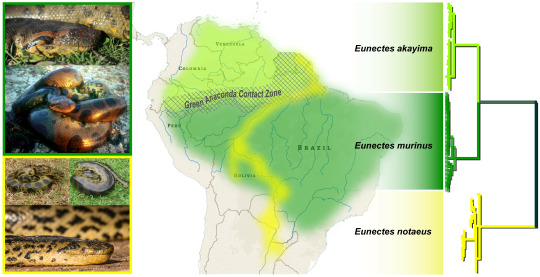
Graphical Abstract, sourced from linked paper, showing revised taxonomy. The Northern Green Anaconda's proposed scientific named is E. akayima. Akayima means "The Great Snake" in the indigenous language of the region.
The paper points out that there are conservation implications behind redefining these species. If the Northern Green Anaconda is accepted as a separate species, habitat loss may impact it more severely than the Southern, who has a wider range. For the the opposite reason, scientists may feel reluctant to group three previously defined species into one, as it could make it more difficult to protect the subcategories.
Read more: Nat Geo article on the findings, Bryan Fry Live Science article
Oh yeah, and one of the scientists who published the article posted this video of an Anaconda that's estimated to be 8 meters long and 200kg. Here's a still:

big dog
394 notes
·
View notes
Text
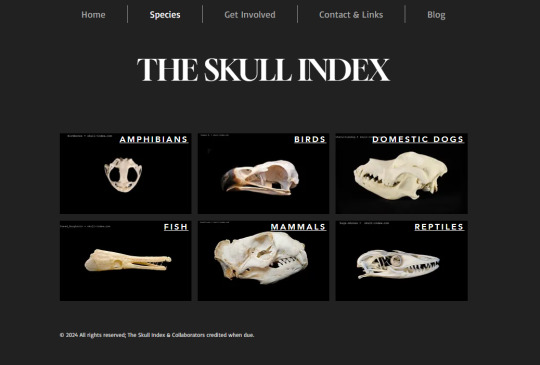


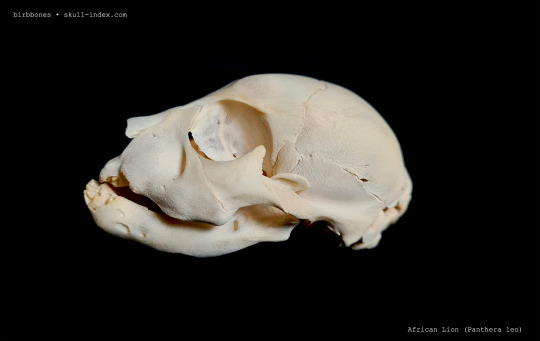
Introducing The Skull Index - A public collaborative resource website.
You might have seen the post @dread-doughnuts made a while back!
While there are various skull resource sites on the web usually dedicated to a certain museum collection or a few museum collections of skulls. This is the first public collaboration skull resource website led by a small team of 5 individuals.
Do you collect skulls? Enjoy collecting and sharing helpful data such as measurements to help compare against other specimens? Consider becoming a collaborator! We currently have over 400 confirmed species on the index, and many more to come!
We are also in touch with various museums and educational institutions across the world, and hope to add some rarer specimens and hopefully extinct vertebrates at the end of the year!
Our hope is that this website will be helpful for anyone. From researchers to students and artists, or to people who are simply interested in bones and skulls and just want to look at neat photos or compare skulls against their own collection for identification help!
Please note that the Skull Index is a work-in-progress website! Most pages for species have not been made yet, our team is working hard on editing photos, compiling the information, and adding new content every day.
Keep up to date with news, join the community hub of visitors, and collaborators, and network with people from the museum industry in our DISCORD SERVER (Please note our server is 18+ only due to privacy and safety).
700 notes
·
View notes
Text
Happy Valentine's Day! When you think about love and the animal kingdom, are alligators an animal that comes to mind? No? Well, they should be, because they have some of the most interesting courtship behavior of any non-bird. (Bird displays are something else entirely.) I think it's time that you all are introduced to the Big Gay Alligator Sex Study, more properly known as Courtship Behavior of American Alligators (Alligator mississipiensis), written by Kent Vliet. You can get the paper at the link below!
This was a study done over a 3-year period in the 80s with a population of captive American alligators to look at how they interacted. Alligators are incredibly social and have complex behavioral dynamics, and their courtship rituals and routines are pretty dang interesting. In general, crocodilians spend a great deal of time interacting with each other when compared to other reptiles, and the courtship behavior of a few species is well-documented. But in this post, I'm mostly going to talk about the American alligator (with a quick detour into Cuban crocs).
Why Do We Care About Courtship?
So before I dive into talking about this study, let's talk about why we care about courtship (the social behavior that leads to mating) and mating (sexual interaction that could, hypothetically, lead to reproduction). Courtship and mating are extremely important when studying animal behavior- honestly, they're extremely important when studying zoology in general. In some cases, understanding this behavior actually a major conservation concern! For example, the Cuban crocodile is an endangered species. They're largely constricted to two swampy areas of Cuba, both of which also have American crocodiles present. And unfortunately, the female Cuban crocs find the male American crocs really, really sexy. This is a big problem, because with only about 3-4,000 Cuban crocs left in the wild (possibly even fewer), they need to be breeding with their own species to make more Cubanitos.

These. Make more of them.
But what scientists have found is that not only are there hybrid crocs in the wild, the Cuban population of American crocodiles is more closely related to Cuban crocodiles than other populations of American crocodiles, suggesting this has been going on for a very long time.
You can read more about that here if you want, but back to the gay alligators.
Alligator? More Like Alli-GAY-tor, amiright?
(actually that IS wrong it's more like alli-bisexual-tor, but that doesn't sound like alligator)

So how does a study like this happen? Back in the 80s, the American population was Feeling A Way about alligators. Something that you gotta understand when you're doing any kind of conservation is that people protect what they love, and they love what they understand. Alligators are a major conservation success story today- there's millions in the wild- but they were in serious danger of extinction in the 1960s, and it was a combination of legislation, awareness campaigns, and captive breeding at both zoological parks and commercial gator farms that helped bring them back. As a result, they were one of the first species to be de-listed from the ESA!
All of this attention meant that alligator science was flourishing in the late 70s and 80s, and that's where this study comes into being. This post is long enough so I'm not gonna go into all the details and methodology- you can find that in the paper I linked up top!
However, there is one piece of methodology we should talk about, and that's the choice of study population. It's part of what makes this particular study so interesting!. See, in a lot of cases, captive behavior really differs from wild behavior. This can be impacted by captivity conditions- what other animals the study animal has access to, what behaviors the animal has learned in captivity, even down to things like how the animals are fed. For example, some courtship behavior in captive animals can be the result of unnatural habitat conditions or limited social groupings. If you only have access to a couple of conspecifics, you don't have the same choices that you do if you have access to something closer to a wild population. If you've got a breeding group with one male and a handful of females, you can't ask or answer any questions about male/male interactions! Crowding is also an issue- too many animals in a space can be stressful, and lead to atypical sexual behavior.
But that's one of the cool elements of this study: the alligators in question live in a large social group in a lagoon that's basically just natural habitat with a boardwalk going around it. It's about as close to studying a wild population as you can get, with the advantage that it's far more accessible. And what this leads to is that that the researchers were able to see a really wide range of behavior, because all of the alligators had lots of access to lots of different mates. They were able to make choices that you wouldn't see in a smaller group. There's a trade-off that Vliet notes, and that is the population density and captive situation means that results might not quite work out the way they do in the wild- but in the years since, the results of the study have been vindicated with research into wild populations.
So, what are alligators into? Gay sex, group sex, yelling real loud, and lots and lots of... gentle caressing.
that's not a euphemism they spend a lot of time gently rubbing each others' faces
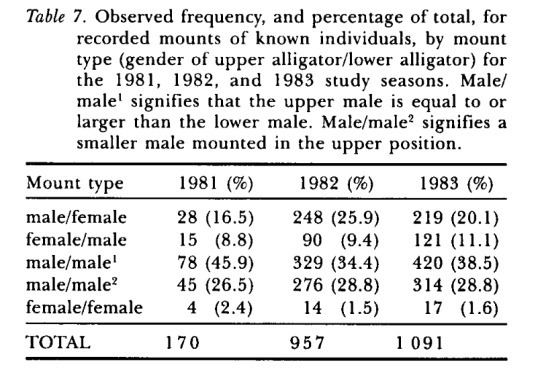
So first things first, it turns out that the vast majority of alligator mounting, which occurs after courtship behaviors like jaw rubbing, bellowing, head rubbing, and swimming together is male/male. Over the three year study period, an average of 68% of all sexual interactions were male/male. However, what they don't really notice is exclusivity, because when it comes to the sex of their sex partner, alligators... well. They aren't all that picky.
Another fascinating aspect of alligator courtship is what's called courtship groups. These are readily observed in captive settings (and in the wild, too, as mentioned in Dragon Songs), and are mixed-sex groups that spontaneously form. As other alligators approach a mounting pair, the original pair will happily split up and switch partners. Usually what happens is that the alligator on top slides off to initiate courtship with a newly-arrived individual. What's really interesting here is that, as the author notes, "males engaged in courtship with a female readily terminate that interaction and initiate interactions with males." Another fun element of alligator courtship is that while in most vertebrates, males approach females, alligator females often approach males. Usually it's the males approaching, but for many crocodilians, courtship initiation is an equal-opportunity affair.
Alligators are also really vocal during courtship! This is pretty unusual for a reptile- usually they're a quiet bunch. But crocodilians are pretty chatty. And during the breeding season, something pretty spectacular happens: infrasonic communication, better known as bellowing. This is sometimes called water dancing, due to the ripple patterns it makes. It's a loud, low-pitched rumble that conveys information about size and location, and is used for territorial displays and as a mating call. During the not-breeding season, a bellow means "stay away!" During the breeding season, it means "HOT ALLIGATOR SINGLES IN YOUR AREA."
Here's some pretty spectacular videos showing you what this looks and sounds like. The vibrations make the water above their backs splash up.
youtube
youtube
Alligators are also extremely tactile during courtship. The study has detailed analysis of touch in specific tactile zones along the head and neck of the alligators. Vliet notes "These sites have increased numbers of swollen pustular scale organs, the function of which is unknown."
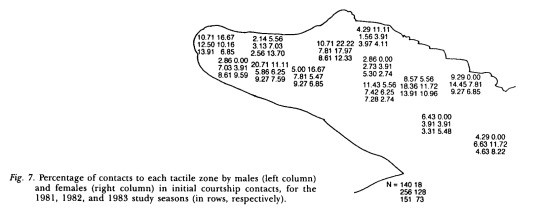
What's kinda funny about this to me is that now, the functions of these organs are known- they're highly innervated tissues that help alligators detect prey in murky water. An alligator's jaws are more sensitive than a human fingertip due to the sheer number of nerve endings! So of course these areas are going to be highly sensitive, and to me it makes perfect sense that they feature so heavily in courtship.
So what can we take away from this 40-year-old study? Quite a bit! First, it's a great reminder that humans aren't special. We see same-sex mating behavior in pretty much every species we look at. We see it in cockroaches, spiders, and butterflies. We see it in sheep. We see it in alligators. We see it in every other species of great ape. Of course we also see it in humans! There's nothing that special about same-sex sexual behavior. It's a part of... pretty much everybody's evolutionary history.
Another thing I think is really important is that while this is an old study, it was absolutely pivotal as a turning point in helping people understand alligators. Remember how I said earlier that we protect what we love, and we love what we understand? This study showed the world that alligators weren't just mindless eating machines. They're socially complex! Understanding alligator sociality and how they choose mates and interact helped us care for them better. It told us more about how to keep them happy in captivity. Alligators are smart, communicative creatures. They don't always get along, but they don't always fight, either. (Don't get me wrong: they will fight each other, and they've actually evolved some pretty specific anti-other-alligator defenses... but they don't always fight, even during the breeding season.) This is interesting to me because in mammals, it's hypothesized that same-sex sexual behavior may have evolved for prosocial reasons; that is, it helps reduce conflicts. Perhaps it does the same for alligators.
In conclusion:
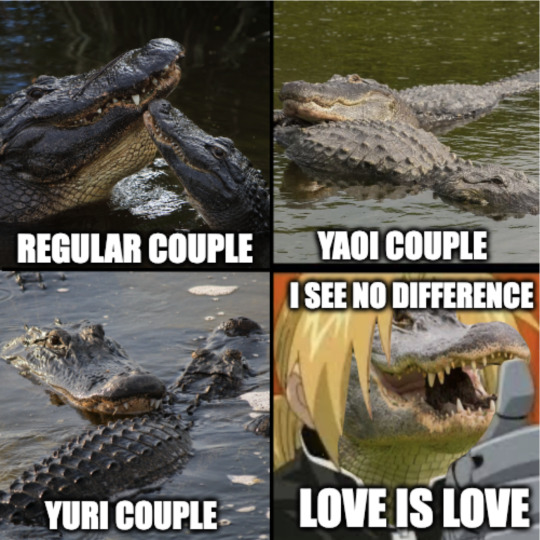
If you want to know more about alligator courtship and mating rituals, I can't recommend Vladimir Dinets's Dragon Songs: Love and Adventure Among Crocodiles, Alligators, and Other Dinosaur Relations highly enough. I know I talk about this book all the time, but it's easily the most accessible writing on crocodilian social behavior. It will change the way you think about and understand these animals.
Another phenomenal book is Alligators: The Illustrated Guide to Their Biology, Behavior, and Conservation by Kent Vliet. (Hm, wonder if he's written anything else...) This is basically the Bible for gator behavior. The photographs are absolutely gorgeous, too.
490 notes
·
View notes
Text


I’m letting go of a ranched red fox softmount, I got it secondhand from a friend but it was originally mounted by Ellie Willingham. I don't know the specific morph, however, the fox was male. It has some minor cosmetic damage and the leather doesn't feel like the best quality. Pics of the damage can be provided on request. He’s a good display piece and I just don’t have the space to display him properly.
I’m asking $250 plus shipping, not open to offers or trades; I am open to short-term payment plans. PayPal Goods & Services only please. Ships from Florida, USA to anywhere else in the USA. I cannot ship this outside of the USA
36 notes
·
View notes
Text
Alligator Body Language and You, or: How To Know When An Alligator On Social Media is Being Stressed for Views
Alligators are wild animals. Despite the idiotic claims of animal abusers like Jay Brewer, they cannot be domesticated, which means they are always going to react on the same natural instincts they've had for millions of years. Habituated, yes. Tamed, yes. Trained, definitely. Crocodilians can form bonds with people- they're social and quite intelligent. They can solve problems, use tools, and they're actually quite playful. Alligators are also really good at communicating how they're feeling, but to somebody who doesn't spend much time around them, their body language can be a bit mystifying. And it doesn't help when social media influencers are saying shit like this:

That is not what a happy gator looks like.
That's a terrified, furious gator who isn't attacking because the ogre handling her has her in a chokehold. She's doing everything she can to express her displeasure, and he's lying about it because he knows his audience doesn't even know how to think critically about what he's doing. He knows that because his audience doesn't know anything about these animals, he can get away with it. This I think is why I hate him so much- he deliberately miseducates his audience. He knows what he's doing is factually inaccurate, he just doesn't care because attention means more to him than anything else in the world.
Let's change that! Here are two really important lessons for understanding alligator body language on social media.
Lesson 1: Alligators Don't Smile (in fact, most animals don't)
So what's going on in this video? Jay Brewer is aggressively choking his white alligator Coconut while scrubbing algae off of her with a toothbrush. And make no mistake, he is digging into the creature's throat while she is visibly distressed. He claims she's happy- but she's not. He is willfully misrepresenting what this animal is feeling. That's a problem, because people... well, we actually kind of suck at reading other species' body language. The reason for this is that we tend to overlay our own responses on their physical cues, and that's a problem. For example, let's look at an animal with a really similar face to ours, the chimpanzee. Check out Ama's toothy grin!
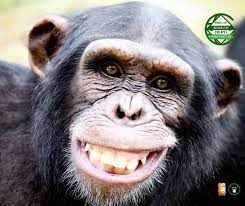
Wait, no. That's not a happy smile. That's a threat display. When a chimpanzee "smiles," it's either terrified and doing a fear grimace, or it's showing you its teeth because it intends on using them in your face.
How about a dog? Look at my smiling, happy puppy!

Oh wait no, this is a picture of Ryder when he was super overwhelmed by noise and people during a holiday party. He'd hopped up in my sister's lap to get away from stuff that was happening on the floor and was panting quite heavily. See the tension in the corners of his mouth and his eyes? A lot of the time when a dog "smiles," the smile isn't happy. It's stress! Why Animals Do The Thing has a nice writeup about that, but the point is, our body language is not the same as other species. And for reptiles, body language is wildly different.
For instance, look at these two alligators. Pretty cute, right? Look at 'em, they're posing for a Christmas card or something! How do you think they're feeling?

Well, I'll tell you how the normal one is feeling. He's annoyed! Why is he annoyed? Because the albino just rolled up, pushed another gator off the platform, and is trying to push this guy, too. I know this because I actually saw it happen. It was pretty funny, not gonna lie. He's not gaping all the way, but he was hissing- you can actually see him getting annoyed in the sequence I took right before this shot. Look at him in this first shot here- he's just relaxing, and you can see he isn't gaping even a little bit.


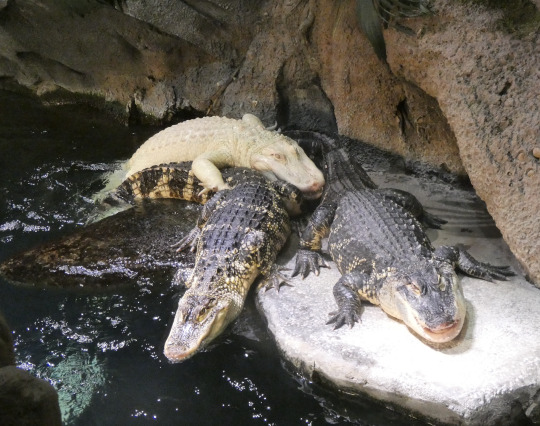
By the end, he's expressing displeasure, but not enough to actually do anything about it. He's annoyed, but he's comfy and that's where one of the best basking areas is, so he'll put up with it.
Reptiles open their mouths wide for a lot of reasons, but never because they are actively enjoying a sensation. Unless they're eating. No reptile smiles- they can't. They don't even have moveable lips. If a reptile is gaping, it's doing so because:
It is doing a threat display.
It is making certain vocalizations, all of which are threats. Alligators are one of the rare reptiles that do regularly vocalize, but most of their calls aren't made with a wide open mouth.
It is about to bite something delicious or somebody stupid. Check out this video- virtually all of the gaping here is anticipatory because these trained gators know darn well that the bowl is full of delicious snacks. (I have some issues with Florida's Wildest, but the man knows how to train a gator AND he is honest about explaining what they're doing and why, and all of his animals are healthy and well-cared for, and he doesn't put the public or his staff at risk- just himself.)
youtube
It's too hot and it has opened its mouth to vent some of that heat and thermoregulate. This is the main reason why alligators will often have their mouths part of the way open, but sometimes they'll open all the way for thermoregulation. This is what a thermoregulatory gape looks like- usually it's not all the way open, kinda more like < rather than V, but you can't say that 100% of the time. Additionally, a thermoregulatory gape... typically happens when it's hot out. If they're inside, maybe they've been under their basking light for too long. Heat's the dominant factor, is what I'm getting at.
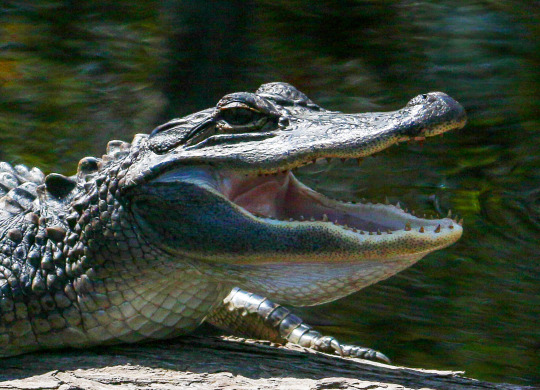
There is another reason that a captive crocodilian might be gaping, and that's because it's doing so on command. Some places have their gators trained to gape on cue, like St. Augustine Alligator Farm and other good zoos. They have the animals do this in presentations that are genuinely educational. They ask the animals to open their mouths so that they can show off their teeth and demonstrate how their tongues seal off the back of their mouth. They'll also do it as part of routine healthcare, because looking at their teeth is important.
In this case, the animals aren't gaping because they're stressed, they're gaping because they know they're gonna get a piece of chicken or fish if they do it. And what's more, they're doing it on cue. They have a specific command or signal that tells them to open wide. It's not an instinctive response to a situation. It's trained. If the animal provides the behavior after a cue, the situation is much less likely to be negatively impactful.
It's also important to remember that there's a difference between a partially open mouth and a gape! As discussed above, alligators will often have their mouths a little bit open just to maintain temperature homeostasis. It helps them stay comfy, temperature-wise. These guys are all doing thermoregulatory open-mouthed behavior- that slight open and relaxed body posture is a dead giveaway. (That and it's the hottest spot in the enclosure.)
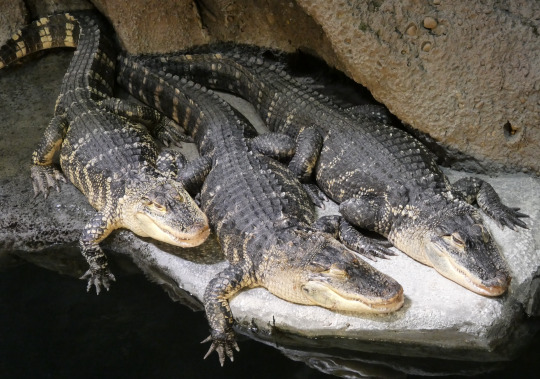
Lesson 2: A Happy Gator Is A Chill Gator
So if alligators don't smile or have facial expressions other than the :V that typically signifies distress, how else can you tell how they're feeling? One way is stillness. See, alligators subscribe to the philosophy of if it sucks... hit da bricks.

Basically, if they hate it, they'll leave. Unless, y'know, somebody has their meaty claws digging into their throat or is otherwise restraining them. (Restraint isn't always bad, btw. Sometimes the animal is going through a medical thing or needs to be restrained for their safety- which a responsible educator will explain.)
Let's look at a very similar scenario, in which a captive alligator is getting his back scrubbed.
As you can see, it's quite different. First, he's not being restrained at all. Second, look at how relaxed he is! He's just chilling there vibing! He could simply get up and leave if he wanted to, because he's not being held. Towards the end of the video, as he lifts his head, you can see that his respiratory rate is very even as his throat flutters a bit. I'm not sure what this facility is, so I can't comment on care/general ethics, but like. In this specific case, this is an alligator enjoying being scrubbed! And you can tell because he's not doing anything. A happy gator is content to be doing what they're doing.
Why Should I Listen To You?
Now, you should ask yourself, why should you listen to me? Why should you trust me, who does not own an alligator, versus Jay Brewer, who owns several?
Well, first off, there's no profit for me in telling you that what you're seeing on social media is in fact not what you're being told you're seeing. I'm not getting paid to do this. That's the thing with people who make social media content. The big names aren't doing it just for fun. They're doing it for money. Whether that's profit through partnerships or sponsorships, or getting more people to visit their facilities, or ad revenue, you can't ignore the factor of money. And this is NOT a bad thing, because it allows educators to do what they're passionate about! People deserve to be paid for the work that they do!
But the problem starts when you chase the algorithm instead of actually educating. A "smiling" alligator gets the views, and if people don't know enough to know better, it keeps getting the views. People love unconventional animal stories and they want those animals to be happy- but the inability to even know where to start with critically evaluating these posts really hinders the ability to spread real information. Like, this post will probably get a couple hundred notes, but that video of Coconut being scrubbed had almost 400,000 likes when I took that screenshot. Think about how many eyeballs that's reached by now. What I'm saying here is that it's just... really important to think critically about who you're getting your information from. What do dissenters say in the comments? What do other professionals say? You won't find a single herpetologist that has anything good to say about Prehistoric Pets, I can tell you that right now.
Another reason you can trust me is that my sources are not "just trust me bro," or "years of experience pretending my pet shop where animals come to die is a real zoo." Instead, here are my primary sources for my information on alligator behavior:
Dragon Songs: Love and Adventure among Crocodiles, Alligators, and Other Dinosaur Relations- Vladimir Dinets
The Secret Social Lives of Reptiles- J. Sean Doody, Vladimir Dinets, Gordon M. Burghardt
Social Behavior Deficiencies in Captive American Alligators (Alligator mississippiensis)- Z Walsh, H Olson, M Clendening, A Rycyk
Social Displays of the American Alligator (Alligator mississippiensis)- Kent Vliet
Social Signals and Behaviors of Adult Alligators and Crocodiles- Leslie Garrick, Jeffery Lang
Never smile at a crocodile: Gaping behaviour in the Nile crocodile at Ndumo Game Reserve, South Africa- Cormac Price, Mohamed Ezat, Céline Hanzen, Colleen Downs (this one's Nile crocs, not American alligators, but it's really useful for modeling an understanding of gape behaviors and proximity)
Thermoregulatory Behavior of Captive American Alligators (Alligator mississippiensis)- Cheryl S. Asa, Gary D. London, Ronald R. Goellner, Norman Haskell, Glenn Roberts, Crispen Wilson
Unprovoked Mouth Gaping Behavior in Extant Crocodylia- Noah J. Carl, Heather A. Stewart, Jenny S. Paul
Thank you for reading! Here's a very happy wild alligator from Sanibel for your trouble.

32K notes
·
View notes
Text
We are still seeking skunk submissions! If you have skunk skulls and would like to contribute please either join the Discord or DM me/ @birbbones !
Call for Submissions: Striped Skunk (Mephitis mephitis) skulls
@birbbones and I are seeking photo submissions of striped skunk skulls for the Skull Index! This will serve as an example of a page with multiple individuals of the same species.
We are seeking examples of male and female striped skunk skulls across the lifespan, including pathological specimens. The page for striped skunks will be linked below, and the best way to get in touch with us quickly is via the Skull Index Discord server. We will also respond to DMs through Tumblr!
24 notes
·
View notes
Text
Call for Submissions: Striped Skunk (Mephitis mephitis) skulls
@birbbones and I are seeking photo submissions of striped skunk skulls for the Skull Index! This will serve as an example of a page with multiple individuals of the same species.
We are seeking examples of male and female striped skunk skulls across the lifespan, including pathological specimens. The page for striped skunks will be linked below, and the best way to get in touch with us quickly is via the Skull Index Discord server. We will also respond to DMs through Tumblr!
24 notes
·
View notes
Text
Happy holidays! We are taking a short break from updating the website but we have some exciting plans for January.
If you’d like to connect with the people running the project or keep up to date on when we resume updating feel free to join our Discord server!
Introducing The Skull Index
Hi all! Now that we are in the early launch phase of the project I’m really excited to share the Skull Index! This is a project a team of friends (led by @birbbones ) have been working on over the last several months; our goal is to provide a high quality free to use anatomy resource. This is meant to be used by anyone from scientists to artists to students. Feel free to check out the website, and if you’d like to stay up to date on the project join our Discord!
The Discord is 18+ for privacy and safety. We hope to see it become a hub for people who are either interested in or currently work in museums, education, and the natural sciences. It is of course open to anyone interested in and enthusiastic about the topic as well. And if you’re interested in collaborating on the project as a please feel free to contact us!
The website is a work in progress though we have a goal of completing it Q1 of 2024. Over 200 mammal species have been logged so far!
1K notes
·
View notes
Text
Introducing The Skull Index
Hi all! Now that we are in the early launch phase of the project I’m really excited to share the Skull Index! This is a project a team of friends (led by @birbbones ) have been working on over the last several months; our goal is to provide a high quality free to use anatomy resource. This is meant to be used by anyone from scientists to artists to students. Feel free to check out the website, and if you’d like to stay up to date on the project join our Discord!
The Discord is 18+ for privacy and safety. We hope to see it become a hub for people who are either interested in or currently work in museums, education, and the natural sciences. It is of course open to anyone interested in and enthusiastic about the topic as well. And if you’re interested in collaborating on the project as a please feel free to contact us!
The website is a work in progress though we have a goal of completing it Q1 of 2024. Over 200 mammal species have been logged so far!
1K notes
·
View notes
Text

An early holiday gift I got myself: a spotted gar (Lepisosteus oculatus) skull. Spotted gar are one of the smallest species of gator found in the United States and occur from the Great Lakes to the Gulf of Mexico. They are not federally protected though they are protected in some states at the northern end of their range. In my state they are relatively common and not at significant risk of extinction.
I don’t have any other fish skulls so I’m excited that my first one is such a cool species.
196 notes
·
View notes
Text



Crocodilian skulls from the St. Augustine Alligator Farm. Two large adult Nile crocodiles (Crocodylus niloticus, top and bottom left) and a large adult saltwater crocodile (Crocodylus porosus). These two species are some of the largest true crocodiles to have ever existed. Nile crocodiles are found throughout most of Africa while saltwater crocodiles are found in the Indian subcontinent, Southeast Asia, Indonesia, Papua New Guinea, the Philippines, and northern Australia.
71 notes
·
View notes
Text




Beetle cleaned reptile skulls and skeletons at the St. Augustine Alligator Farm. These skeletons were part of a display discussing poaching and how educational institutions process deceased animals for educational use.
151 notes
·
View notes
Text
Dog skull is sold!
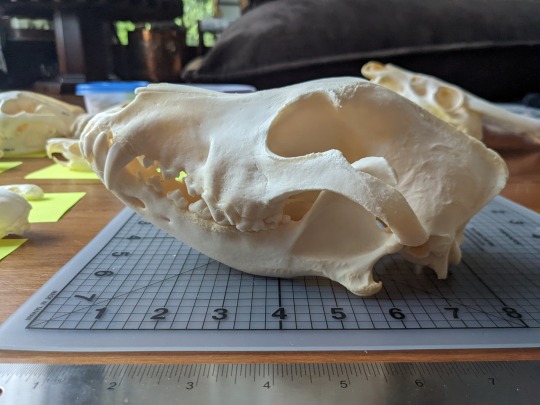
I have a domestic dog skull looking for a new home. It came from a friend’s comparative set that they have divested, and I don’t collect domestic dogs or cats.
The skull is A grade, meaning it has all teeth, nasal turbinates, and does not have visible damage or significant discoloration.
It costs $80 plus $10-13 for US shipping. I can ship this skull anywhere in the US, and since it’s a domestic animal I can ship it to certain international countries as well (though shipping will be much more expensive and takes longer).
I’m open to short-term holds and payment plans. However, if you can pay before December 16th I can ship before Christmas.
PayPal only please! DM if you’re interested.
49 notes
·
View notes